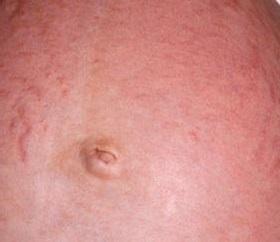Polymorphic eruption of pregnancy (PEP)
Last reviewed dd mmm yyyy. Last edited dd mmm yyyy
- extremely pruritic condition of the last trimester of pregnancy
- usually affects primigravidae in the last weeks of pregnancy or immediately postpartum (15%)
- incidence is about 1:160 pregnancies and the condition is associated with excessive maternal weight gain and multiple pregnancies
- rash usually begins on the abdomen, often within, or adjacent to, striae distensae, as erythematous papules coalescing into erythematous plaques, which spread over a few days to involve the trunk and proximal extremities. PUPPP resolves spontaneously or after delivery, which is helpful for confirmation of the diagnosis, and is responsive to topical and oral corticosteroids
- pathogenesis of polymorphic eruption of pregnancy remains unclear
- main theories proposed focus on abdominal distension, hormonal and immunological factors
- fact that polymorphic eruption of pregnancy starts within striae distensae at the time of greatest abdominal distension favors connective tissue damage due to overstretching to play a central role
- increase of CD1a cells in the inflammatory infiltrate could confirm the theory that previously inert structures develop antigenic character, thus triggering the inflammatory process
- hormonal and immunological changes have not definitively been shown to play a role; nor has an association with increased birth weight or male sex of the newborn been confirmed
- fact that polymorphic eruption of pregnancy starts within striae distensae at the time of greatest abdominal distension favors connective tissue damage due to overstretching to play a central role
- main theories proposed focus on abdominal distension, hormonal and immunological factors
- begins in the abdominal striae (consists of erythematous or urticarial plaques or papules) without excoriations

- lesions may spread to the trunk, arms, thighs and buttocks
- resolves with delivery of the baby or shortly after
- tendency not to recur in subsequent pregnancies
- diagnosis of PUPPP mostly depends on the clinical findings since histological findings are not specific
- differential diagnosis includes other pregnancy-related dermatoses presenting with pruritus (prurigo gestationis, herpes gestationis, pruritus gravidarum and impetigo herpetiformis)
- direct immunofluorescence is negative
Management:
- symptomatic treatment with topical corticosteroids with or without antihistamines is usually sufficient to control pruritus and skin lesions
- in severe generalized cases, a short course of systemic corticosteroid may be necessary and is usually very effective
Reference:
Related pages
Create an account to add page annotations
Add information to this page that would be handy to have on hand during a consultation, such as a web address or phone number. This information will always be displayed when you visit this page